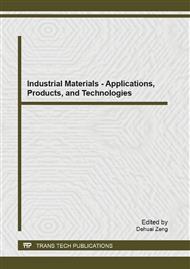p.3
p.7
p.12
p.16
p.21
p.26
p.30
p.34
Reduction Nitridation Synthesis of Bauxite Based β-SiAlON by Aluminum / Silicon Compound
Abstract:
Study of aluminum / silicon compound reduction nitridation synthesis of bauxite-based β -Sialon reaction process, using mass change ratio of the specimens and XRD, SEM, EDS analysis. The results were compared with the specimens separately using Al and Si reducing agent.The results show that:at 1100 only Al reacts with N2 and SiO2 to form AlN and Si; At 1200~1350°C, Si takes part in reduction-nitridation with subsequent formation of SiAlON;At 1450~1550°C,there is noticeable increase in β-SiAlON formation, the appropriate temperature is 1500°C.The amount of β-SiAlON formed is higher and crystale growth is better than that of single reducing agent.
Info:
Periodical:
Pages:
12-15
Citation:
Online since:
August 2013
Authors:
Price:
Сopyright:
© 2013 Trans Tech Publications Ltd. All Rights Reserved
Share:
Citation:


